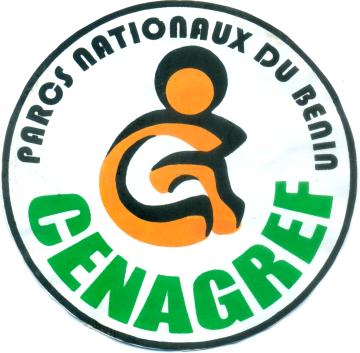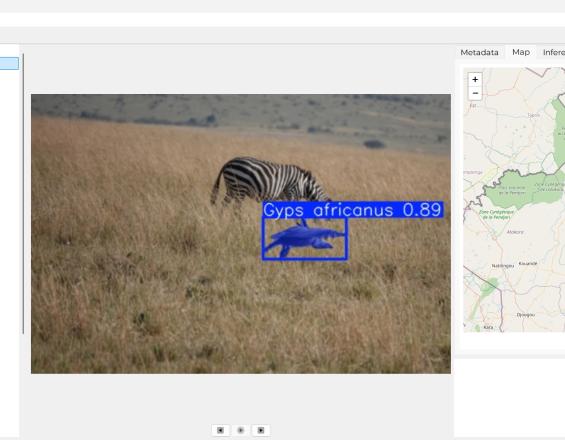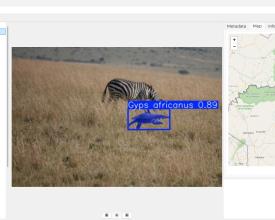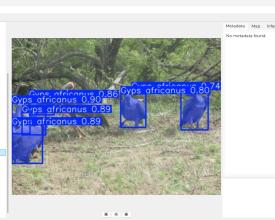
Computer vision for vulture species monitoring across Africa

This AI-powered solution supports Global Biodiversity Framework (GBF) Targets 17 and 20 by leveraging biotechnology to strengthen species monitoring and fostering technology transfer for biodiversity conservation. Using a deep learning model, "You Only Look Once version 11" (YOLOv11), it automates the identification and analysis of critically endangered vultures (Gyps africanus, Gyps coprotheres, Gyps rueppelli, Torgos tracheliotos) in drone and camera trap data. Data from African Parks Network (APN), Southern African Wildlife College (SAWC), Endangered Wildlife Trust (EWT), platforms like iNaturalist, and GBIF will serve to train and validate the model.
The project tackles challenges like labor-intensive monitoring and data gaps. Its open-source design promotes accessibility, collaboration, and capacity-building across African conservation networks, directly addressing gaps in biodiversity data and monitoring systems.
Context
Challenges addressed
Environmentally, the solution combats population decline by enabling accurate monitoring of critically endangered vultures. This aids targeted conservation and helps protect their ecological role as scavengers, essential for preventing disease spread and maintaining ecosystem health (Den Heever et al., 2021). Socially, our solution aims to monitor vultures effectively with camera trap (de Freitas et al., 2025; Fernández-Bellon et al., 2017; Harrison et al., 2019; Maphalala & Monadjem, 2017), since the traditional monitoring using camera trap remains challenging (Young, Rode‐Margono, & Amin, 2018; Vélez et al., 2023). It tackles the lack of awareness about vultures' importance by generating data to support educational campaigns and offers an accessible, open-source tool that empowers conservationists with limited resources. Economically, it reduces the high costs of traditional monitoring, which relies on labor-intensive surveys.
Location
Process
Summary of the process
The success of this integrated solution relies on how its components reinforce each other: The data collection and AI development (Block 1) provides the foundation of high-quality model training data that powers the Declas monitoring tool (Block 2), ensuring accurate species detection. This technological capability then enables the capacity building and advocacy program (Block 3) to effectively transfer skills to conservation practitioners. Local partner networks amplify this impact by facilitating both data collection and beneficiaries training participation, while post-training support ensures sustained tool adoption.
Building Blocks
AI-powered vulture species recognition model
The building block aims to automate vulture monitoring by developing a model to detect and classify four vulture species (Gyps africanus, Gyps coprotheres, Gyps rueppelli, Torgos tracheliotos) from visual data, reducing manual effort, speeding up analysis, and ensuring consistency. It leverages Google Colab Pro+ to run Python code and train the model on large image datasets, utilizing the Ultralytics package with YOLOv11 for vulture classification. Images are stored on a 2 TB Google Drive, sourced from the iNaturalist database via the rinat R package and supplemented by data from the Southern African Wildlife College and Endangered Wildlife Trust. The Computer Vision Annotation Tool (CVAT) team plan enables collaborative image annotation, allowing multiple users to label and export images with annotations for training and validation.
Enabling factors
- A high-quality, annotated dataset with diverse images representing the target species in different environments and conditions.
- Access to computational resources (Google Colab Pro+)for training and validating the AI model.
- Collaboration with conservationists to validate the model’s results in field conditions.
Lesson learned
- Ensure the dataset is representative of real-world conditions to avoid bias in detection (e.g., lighting, angles, habitats).
- Regular updates to the model with new data improve accuracy and adaptability.
- Challenges include misclassifications due to overlapping species traits; having experts validate initial results is essential.
Resources
Open-source software for vulture monitoring
This building block leverages Declas, an open-source AI tool, to automate vulture monitoring. By analyzing images or videos, it detects and classifies species with high accuracy. The system eliminates manual counting, enabling scalable, cost-effective wildlife tracking. Users—researchers, rangers, or conservationists—simply upload visual data, and the tool generates real-time insights for informed decision-making. Built on YOLOv11 (Ultralytics) and trained on crowdsourced data.
Enabling factors
- A simple and intuitive user interface to ensure accessibility for non-technical users.
- Documentation and training resources for users to understand and effectively utilize the application.
- Community feedback to continually enhance the tool’s usability and features.
Lesson learned
- Usability is key; overly complex interfaces deter users.
- Offering technical support and clear documentation ensures broader adoption.
- Integration challenges included aligning the AI model’s output with user-friendly visualization tools; iterative testing was essential to resolve this.
Resources
Hybrid training & conservation advocacy
This building block provides hands-on training for researchers and conservationists in Benin and South Africa (offline) and globally (online via Zoom) on using Declas. The sessions cover:
- Software use: Uploading data, interpreting AI-generated results, and integrating findings into conservation strategies.
- Conservation advocacy: Raising awareness on vulture decline and AI’s role in scalable monitoring.
Trainees will learn to deploy Declas in field surveys, reducing reliance on manual counts while improving data accuracy. The hybrid approach ensures broad accessibility, empowering local teams with cost-effective technology.
Enabling factors
- Reliable internet and power for online/offline sessions.
- Local partner support for logistics and engagement.
- Pre-training preparation (materials, software setup).
Impacts
The project has demonstrated significant positive impacts across environmental, social, and economic dimensions.
Environmental Impacts
The AI-powered model was tested in Sota, Trois Rivières, and Alibori Supérieur Forest (Benin) and Kempiana and Manyeleti reserves (South Africa). Across these sites, it accurately identified Gyps africanus in over 89% of analyzed images, confirming their presence in these ecosystems. In Benin, it detected a 15% higher abundance than previous manual surveys, underscoring its effectiveness in providing reliable data for monitoring vulture populations. By identifying peak daily activity patterns, it helped refine conservation strategies, such as ensuring carcass availability during peak feeding times.
Social Impacts
Declas software has already been downloaded more than 90 times since its release 4 months ago (https://zenodo.org/records/14166440) without promotion or hybrid training.
Economic Impacts
The tool significantly reduced monitoring costs by 40%, saving resources previously spent on post field surveys with camera trap. The protection of vultures indirectly benefited local economies.
Beneficiaries
African conservation organizations, researchers, and local communities benefited through improved species monitoring, enhanced data access, capacity-building, and strengthened conservation outcomes for critically endangered vultures.
Additionally, explain the scalability potential of your Solution. Can it be replicated or expanded to other regions or ecosystem?
The solution has strong scalability potential and can be replicated in other regions or ecosystems globally. The AI model can be retrained with local data to monitor different species, while the open-source application ensures accessibility for diverse conservation teams. For example, it could expand to monitor scavenger species in Asia or Latin America, or even other keystone species, such as predators or pollinators. By leveraging partnerships with global conservation networks, the solution can integrate datasets from multiple regions to enhance its adaptability. With minimal adjustments, it can also be applied to different ecosystems, from savannas to temperate zones, provided relevant image data and species annotations are available. Its cost-effectiveness and user-friendly design make it accessible for teams with limited resources, further enabling widespread adoption.
Global Biodiversity Framework (GBF)
Sustainable Development Goals
Story
In the heart of the Sota in Benin, a young conservationist named Ange stood in front of a camera trap, marveling at the sight of vultures captured in the frame. These vultures were not just part of the park's wildlife; they were an indicator of the park’s ecosystem health and vital to the surrounding communities. But despite their importance, vultures, especially the critically endangered Gyps africanus, faced massive threats from poisoning, habitat loss, and lack of adequate monitoring.
Ange had long been involved in wildlife conservation but found it frustrating to track species like vultures using outdated and labor-intensive methods. Surveys were often sporadic, and even experienced conservationists struggled with the time-consuming task of manual identification of vulture species. The need for a more efficient and accurate way to monitor these birds was clear, but it was unclear how to make that leap. That was until Ange learned about our solution. He was intrigued and had seen firsthand how limited resources often hindered effective monitoring, and this seemed like the perfect way to ensure more accurate, real-time data.
Ange and her team began using the tool in Sota. Within the first few months, they saw a dramatic shift in how they operated. The tool not only identified vultures with accuracy but also helped track their daily activity and population density. In Kempiana and Manyeleti Reserves in South Africa, where the model was also tested, the results were equally transformative. Researchers were now able to quickly assess vulture presence and behavior without hours of fieldwork.
The impact on Aminata’s work was profound. No longer was she limited by the constraints of traditional methods. Instead, she now had access to a robust, scalable, and efficient monitoring tool that not only supported vulture conservation but also contributed to the long-term sustainability of ecosystems in Africa. Aminata’s success story is a testament to the power of innovation in conservation. It shows how the fusion of technology and local expertise can create real change in protecting vulnerable species and ensuring the health of our planet.





